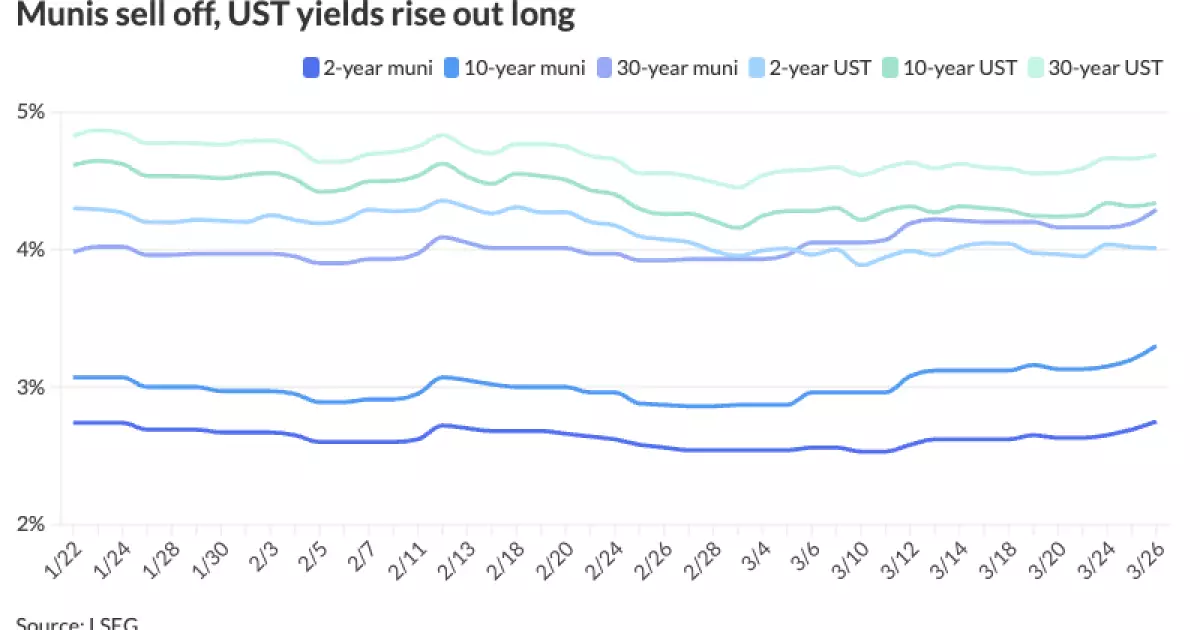The current state of the municipal bond market illustrates a precarious conundrum that many investors seem to misunderstand. On the surface, the municipal market showed slight resilience with a reported $19 million inflow from the Investment Company Institute (ICI) amid outsized prior weeks of $376 million. However, this dichotomy underscores deeper vulnerabilities that cannot be glossed over with optimistic headlines or statistical cherry-picking. The marked volatility and dubious health of municipal bonds have raised eyebrows and prompted serious questioning about whether this sector can sustain itself in an increasingly fraught economic environment.
The recent uptick in municipal yields—from two to twelve basis points—emphasizes a critical market alarm. Backed by the Federal Reserve’s monetary policies and inconsistent liquidity flows, the changes reveal a market uncomfortable in its own skin. Municipal bonds, long considered a safe refuge for investors, are exhibiting signs of distress that should instill a sense of caution rather than comfort. The pronounced rise in U.S. Treasury yields—up to three basis points—adds further stress, pushing the market into a tighter, risk-averse design.
Buyers Beware: A Potential Illusion of Stability
Despite the immediate influx of cash into the municipal market, it’s vital to dissect where that money is truly coming from. The ICI noted an increase in exchanges-traded funds with an inflow of $306 million contrasted against an outflow of municipal mutual funds amounting to $216.4 million. What may seem like a positive net gain appears deceptive given the broader picture of fiscal imbalance. The municipal community must confront the uncomfortable truth that many traditional investors have begun to withdraw in the face of perceived instability driven by rogue market conditions.
The nuances in municipal-to-Treasury yield ratios highlight the fragility of this market. With the two-year municipal-to-Treasury ratio standing at 69%—just below desirable thresholds—investors should be wary of the deterioration in confidence levels among market participants. Those in the business of buying and selling municipal bonds, such as primary securities’ underwriters, are seemingly trapped in a tightening liquidity squeeze, forging a disconnect between institutional objectives and market realities.
A Volatile Marketplace Shifting Dynamics
Market experts like James Pruskowski from 16Rock Asset Management have pointed out the “aggressive selling” witnessed ahead of quarter-end, one that permeates the market dynamics. As liquidity becomes “as strained as it has been in a long time,” investors would do well to tread carefully in this evolving landscape. The burgeoning macro risks, including shifting tariffs and evolving economic data, compound these challenges. Such elements introduce unpredictability, leading to what can be seen as a looming storm cloud over the municipal bond market, essential for regional funding.
Closer examination reveals that while the larger investor base has moved to the sidelines, they’re no longer comfortable with the rates offered in return for the risk they’re expected to take. The best-known municipal bond deals—like New York City’s multi-billion-dollar issuance—face increased scrutiny, as investors search for the right spread for yielding returns. A bond market riddled with uncertainty is one where buyers become increasingly skittish, and it appears the capacity for the municipal bonds to entice much-needed investment is dwindling.
Positioning in Search of a Catalyst
Market volatility is not merely the concern of secondary traders but is a collective worry among all factions involved in the municipal bond landscape. While some view the widening municipal-to-U.S. Treasury ratios as a long-term benefit, others see the immediate challenges overshadowing potential rewards. The market is, by its nature, cyclical; however, the current re-pricing indicates a need for patience from all involved.
The balance of power seems to be shifting, and with that shift, a unique opportunity can arise. Pruskowski suggests that the current turmoil may present an opportunity for shrewd investors willing to navigate the labyrinth of uncertainty. Only those who can manage risk effectively will be able to seize potential gains; however, this requires a radical shift in how they perceive the value of their investments.
As the municipal market maneuvers through an intricate maze of recalibrating valuations and evolving broader dynamics, the need for vigilance and strategic positioning has never been more critical. Investors must remain acutely aware of the fragility of the market, ensuring that they are not lulled into complacency by fleeting inflow figures that mask deeper, relentless issues.


Leave a Reply